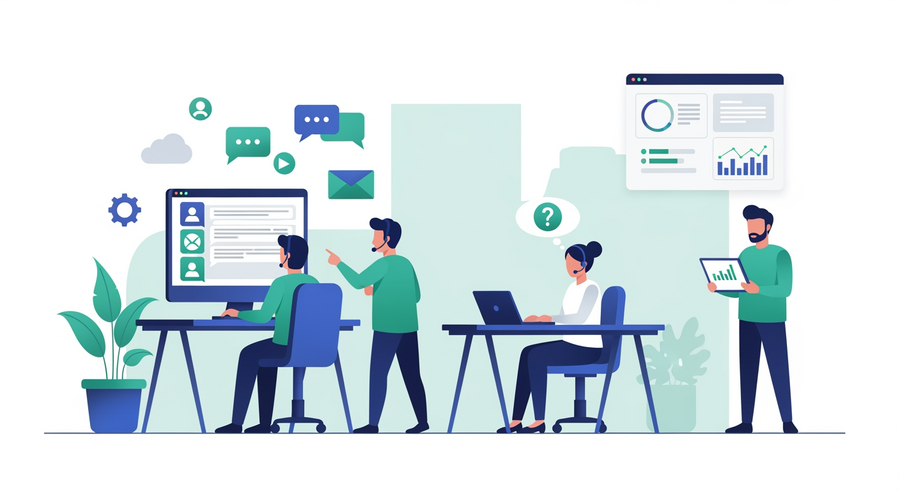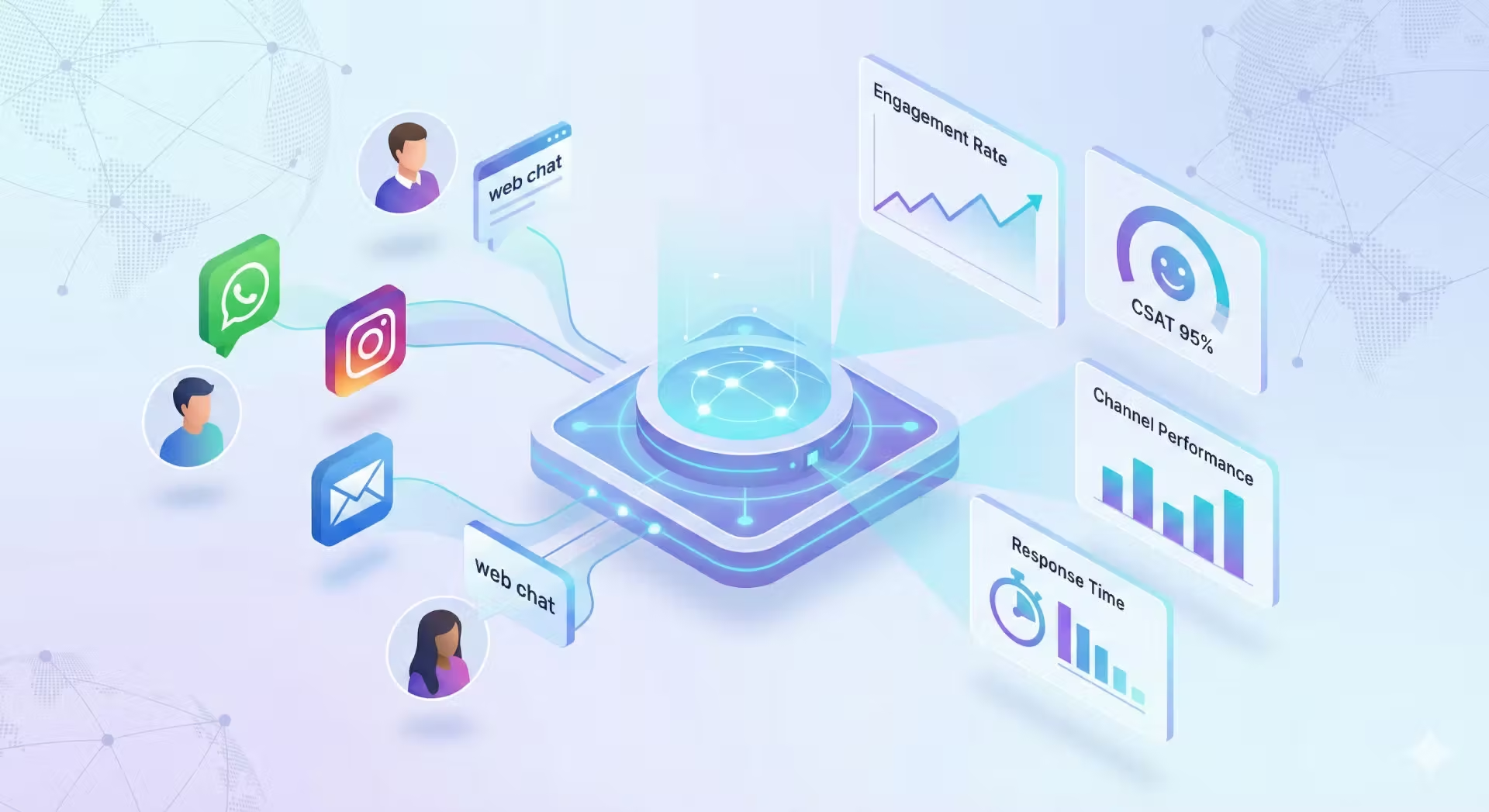Over 71% of companies have added a chatbot to their website. It's an easy and effective point of contact between businesses and customers.
Yet, there are still people out there using chatbots to get in contact with businesses and not walking away with a satisfying experience.
We don't want that to be you.
That's why in this guide, we’ll walk you through how to add an AI chatbot to your website – one that people will actually like to use. Setting up a chatbot on your website can transform customer interactions by providing quick, automated assistance anytime they need it. So let's explore how you can add a chatbot that gives you all these advantages and more.
What is a website chatbot?
A website chatbot is a smart assistant that interacts with visitors on your site. It can
- Answer customer questions instantly
- Provide 24/7 support and assistance
- Guide users through the purchasing process
- Collect customer feedback
- Qualify leads and direct them to sales teams
- Share information about promotions and offers
- Schedule appointments and send reminder
Whether it's an AI chatbot on a website, or a simple rule-based bot, it helps enhance user experience by being available 24/7, and giving customers answers whenever they need them.
How does a website chatbot work?
Website chatbots operate based on two main types: rule-based and AI-powered.
Rule-based chatbots stick to a set script to respond to user questions. They are often referred to as “if-then bots” because they match keywords in the user’s query to pre-written answers. If a user asks for “X” then the bot will respond with “Y”.
This makes them perfect for handling simple, common questions. Because they’re straightforward to set up, they’re great for basic customer support tasks.
AI-powered chatbots use natural language processing (NLP) to understand what users are really asking and provide spot-on answers. These chatbots get smarter with every interaction, learning and adapting over time.
They can tackle more complex questions by using their vast knowledge base and historical data from previous enquiries. They are also able to engage with users in a way that is more conversational and feels natural and intuitive.
💡 By using these rule-based or AI technologies, a chatbot on a website can greatly improve customer engagement and support. It will enable customers to get direct and fast answers about things such as when a time might be back in stock or more details about a product that could help them in their buying decision.
Different types of chatbots you can use on your website

How to add a chatbot to your website - 7 Easy Steps
Adding a chatbot to your website doesn't have to be complicated. Here is a simple 7-step guide to get started.
1. Identify your chatbot’s purpose
Before you start building your chatbot, you need to consider what you want it to do and how it will help you achieve business goals. Are you aiming to boost customer service, increase sales, or gather leads?
Knowing your chatbot’s goal will help you choose the right type of chatbot for your business needs. For instance, a customer service chatbot can handle common inquiries and provide 24/7 support, reducing the burden on your live agents.
For example, a lead generation chatbot can interact with site visitors, collect their contact information, and qualify them for sales follow-ups.
By defining your chatbot’s purpose, you can tailor its functionality to meet specific business objectives from the beginning. This will help ensure that it provides value both to your business and your customers and that your customers will use it. Start by figuring out the main problems you want the chatbot to solve and the key metrics you’ll use to measure its success.
2. Choose the right chatbot platform
If you’re looking for a straightforward solution with minimal coding, consider using a user-friendly chatbot builder. These platforms offer drag-and-drop interfaces that make it easy to design and deploy chatbots quickly.
Look for platforms that provide greater flexibility and advanced features for more advanced chatbots that use NLP or need more complex integrations.
When choosing a platform, consider factors like ease of use, scalability, integration capabilities with your existing systems, and cost. Additionally, look for platforms that offer the analytics and reporting tools you need to help you track your chatbot’s performance. For example, you could use Trengo's AI HelpMate, which provides a great balance of these features, such as FAQ response, instant replies and localisation.
3. Define your chatbot’s personality
Your chatbot is technically a robot, but you don't want it to sound like one. When you give your chatbot personality you make it easier and more enjoyable for your customer and website visitors to engage with it.
For example, Sephora's chatbot Ora is dedicated to millennials and suggests personalised content such as news stories, the latest trends or beauty coaching via tutorial videos and tips. This led to 20% of clients being serviced by Ora and highlights the importance of setting goals and personality so that your chatbot resonates with your customers; otherwise, they won't use it.
Start by considering your brand’s voice and tone. Is your brand friendly and casual, or professional and formal? For example, if your brand is playful, your chatbot can use emojis, humour, and a conversational tone. Choose a name for your chatbot that aligns with its personality.
A well-defined personality helps humanise your chatbot, making it more relatable and engaging for users. But remember, the chatbot should be an extension of your brand, so keep it aligned with your overall brand guidelines.
4. Design the conversation flow
Creating a smooth and intuitive conversation flow is key to a successful chatbot on your website. Start by mapping out your users’ journey. What questions will they ask? What tasks do they need help with? Outline the steps your chatbot will take to assist them.
Use flowcharts or diagrams to help you visualise these paths. Each interaction should be clear and logical, guiding users effortlessly through your site and sales funnel.
It can also be a great idea to include options for users to navigate back, start over, or connect with a live agent if they need to. These types of actions can remove many of the frustrations that users experience with chatbots.
You will then want to test the conversation flow with real users to spot any issue points or dead ends. Designing a well-structured flow'll create a seamless experience that keeps users happy.
5. Build and customise
Now, it's time to bring your chatbot to life. Using your chosen platform, start building the chatbot according to the conversation flow you’ve designed.
You can also start to consider design elements like matching the chatbot’s appearance to your branding, including colours, fonts, and logos.
Set up the various elements of your chatbot, such as welcome messages, question prompts, and response buttons. Add media elements like images, videos, and links that fit your brand tone to help make interactions more engaging.
Ensure that the chatbot can handle different types of user inputs, including text, voice, and button clicks, if you expect visitors to your site to use them.
Then comes the moment to test each component thoroughly to ensure it works as expected.
If your chatbot platform allows, set up integrations with other tools and systems you use, such as CRM software or email marketing platforms. This customisation process ensures your chatbot is functional and integrates with your broader business processes.
6. Deploy your chatbot on your website
Now that your chatbot has been built, tested and is ready to go, it's time to deploy it on your website. Most platforms make this easy with code snippets or plugins. Place the chatbot on your website where it can be most helpful, like your homepage, support page, or product page.
An excellent tip to consider with your deployment is to have your chatbot lazy load after your page loads. Chatbots can sometimes use heavy code that could slow down your site load speeds, harming user experience. So lazy loading means it's still there and valuable but it shows up after all of the other main content on a page.
7. Monitor and Optimise
Once your chatbot is live, you don't want to forget about it. You should continuously monitor and optimise it to ensure the most significant impact possible. Use your chatbot platform's analytics and reporting tools to track key metrics, such as user engagement, conversation completion rates, and user satisfaction.
Identify any areas where users are dropping off or encountering issues and figure out why this is and then make the necessary adjustments.
Update the chatbot’s knowledge base regularly to ensure it remains accurate and helpful. For example, you should ensure it's up to date on stock levels or new product information.
By continuously optimising your chatbot, you’ll ensure it becomes and stays a helpful tool for your business and provides the best possible information for your website visitors.
Why should you add an AI chatbot to your website?
Adding an AI chatbot to your website is a game-changer. It improves customer satisfaction, reduces stress for your customer service teams and can help increase website conversions. Here's how.
- 24/7 support: AI chatbots provide round-the-clock assistance, answering customer queries anytime, outside business hours or during holidays. This means that no customer's question goes unanswered and customers always feel supported.
- Cost savings: AI chatbots automate routine inquiries, reducing the need for additional customer support staff. This can cut down operational costs and allow your teams to focus more of their time on more complex issues.
- Improve engagement: With interactive and instant responses, AI chatbots engage website visitors. They enhance the overall experience on your website and encourage users to spend more time there, which can lead to more customer conversations.
- Data collection: AI chatbots gather valuable insights on customer preferences and behaviour, providing data that can help you tailor your services and marketing strategies.
Examples of AI website chatbots
Sephora: Ora, the virtual beauty coach
Sephora’s chatbot, Ora, combines customer service with personalised beauty tips. Available on Sephora France’s Facebook page and Messenger, Ora answers questions about frequent shopper points, product availability, and order tracking. It also offers personalised content like the latest trends and beauty tutorials. Ora is integrated with Sephora’s systems, providing a seamless user experience and handing off to human agents when needed. This has resulted in over 20% of client requests being handled successfully by the chatbot.
BAS World: automated lead generation
BAS World, Europe’s largest truck and trailer dealer, uses an AI chatbot for 24/7 lead generation. With Trengo, the chatbot handles inquiries in over 13 languages, schedules appointments, and provides product information. This automation ensures no leads are missed, even outside business hours. Leads are integrated into their ERP system, allowing the sales team to follow up efficiently. This personalised approach has significantly increased engagement and lead generation, contributing to higher sales and better customer service.
Trengo: Your AI chatbot Solution for your website and more
Ready to transform your website interactions? With Trengo, you can easily add a chatbot to your website and start reaping the benefits of automation and an improvoed customer experience. Our platform makes adding an AI chatbot to your website simple, providing 24/7 support, increasing lead generation, and improving customer satisfaction.
Let Trengo help you streamline your operations and elevate your customer service today.




.png)











